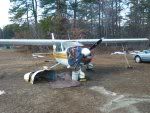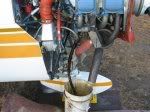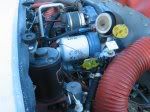Saturday, January 01, 2005
Let's Change the Oil
Today, At exactly 2250 hours on the engine, according to the tachometer, Yellowbird got a fresh helping (8 quarts) of Shell 15W-50 oil. Her last oil change was done during her annual inspection in August of last year, about 29 engine hours ago.25 hours is often quoted as the recommended interval between oil changes. Yellowbird has an oil filter, (not all small aircraft have one) which means that she could go for a longer time between oil changes, but I'd like to keep in the 25 hour range. Clean fresh oil means a lot to an engine's happiness. Today's weather calls for mild temperatures, so this offers a rare opportunity to do some outdoor work without risking frostbite. The engine has been run for a few minutes on the ground to warm up the oil, and we're ready to start.
 Changing the oil on a Cardinal is fairly easy, and in some ways, it's easier than doing the same to a car. In fact, the most difficult part is putting the cowling back on afterwards. The first step is to remove the top and bottom cowlings to gain access to the engine compartment. This involves removing 12 screws and loosening about 24 cowl fasteners, as well as disconnecting the cowl flap actuators and unplugging the landing light wiring harness.
Changing the oil on a Cardinal is fairly easy, and in some ways, it's easier than doing the same to a car. In fact, the most difficult part is putting the cowling back on afterwards. The first step is to remove the top and bottom cowlings to gain access to the engine compartment. This involves removing 12 screws and loosening about 24 cowl fasteners, as well as disconnecting the cowl flap actuators and unplugging the landing light wiring harness. Once this is done, draining the oil is a simple matter of fitting a length of rubber hose over the quick drain plug on the oil pan and letting the oil drain into a handy bucket. While the oil is draining, the oil cooler is also drained by disconnecting the oil line. It can take several minutes for the oil to drain, so this is a good opportunity to examine the engine for any leaks or other anomalies.
Once this is done, draining the oil is a simple matter of fitting a length of rubber hose over the quick drain plug on the oil pan and letting the oil drain into a handy bucket. While the oil is draining, the oil cooler is also drained by disconnecting the oil line. It can take several minutes for the oil to drain, so this is a good opportunity to examine the engine for any leaks or other anomalies. Once the oil has drained fully, the oil filter is removed using a 1" socket fitted over the nut on the end of the filter. The new filter is marked with the date, engine hours, and aircraft registration number, and installed just like an automotive type oil filter. It is then tourqued to the specifications stated in the Cardinal service manual, and safety wire is twisted between the tab on the end of the filter and the engine accessory section to prevent the filter from coming loose.
Once the oil has drained fully, the oil filter is removed using a 1" socket fitted over the nut on the end of the filter. The new filter is marked with the date, engine hours, and aircraft registration number, and installed just like an automotive type oil filter. It is then tourqued to the specifications stated in the Cardinal service manual, and safety wire is twisted between the tab on the end of the filter and the engine accessory section to prevent the filter from coming loose.Finally, after ensuring that the oil filter, quick drain plug, and oil cooler line are properly secured, eight quarts of AeroShell 15W-50 oil are poured down the oil filler tube. Then comes the chore of buttoning everything back up. The Cardinal has many virtues, but ease of attaching the lower cowling is not among them. It's at least a two person job, and a fresh layer of mud on the ground on an unseasonably warm day only adds to the enjoyment.
At last the job is done, and it's time to head indoors to thaw out. Then it's back to the airport to remove the top cowl again and plug the landing light back in, since I forgot that item when I previously put everything back together. Now at last Yellowbird is ready for the next 25 hours of aerial adventure, and I'm ready for dinner.

Very interesting Scott, you are better than me. I usually get as much oil on me as in the bucket when I change the oil. Time before last change I got most of the oil in the bucket. When I went to pour the oil in the waste barrel, I spilled most of the bucket on the floor (the funnel slipped oops).
Conway
Should be able to do complete oil and filter change with out removing the lower cowl. Might consider adding just 7 quarts after a change, the eighth tends to end on the belly is short order. There's info on the CFO web site regarding this.
Carl
Carl,
I've got a preoiler installation that rearranges some of the oil cooler plumbing, so it's a lot easier to drain the oil cooler with teh bottom cowl off. And this way, all the spilled oil goes on the ground, not on the bottom cowl.